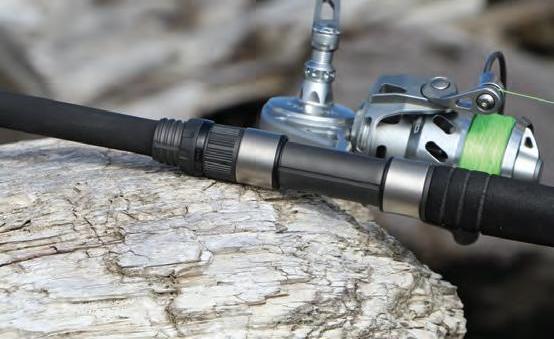
3 minute read
Prolong Rod Life, Performance
from LAMIGLAS 2020 EN
Prolong The Life And Performance of Your Lamiglas Rod
Lamiglas fishing rods are built with the finest materials available and constructed to exacting standards. Our expectations of every rod are extremely high. With some common sense and careful handling, your Lamiglas rod will offer a lifetime of exceptional experiences. The following are some tips and tactics that will help out along the way.
Advertisement
Line Ratings
The individual characteristics built into each and every Lamiglas rod highlights the rod’s intended use. As a part of that, the strength and flex of the blank is balanced to the recommended line ratings. A Lamiglas rod is rated so that when the rod is held at a 45-degree angle or less, line will break before the rod does. Angles greater than 45 degrees transfer undue stress to the tip section of the rod (practically eliminating the ability of the stronger butt section to carry any load), and in extreme cases can result in rod failure with as little as two pounds of directed pressure. This is known as “high sticking.” It is not only proper use that requires a rod angle of 45 degrees or less, but this is also the area where you’ll find the greatest power from the rod and have the best control over the fish.
Transportation
Lure Ratings
Lure ratings provide a range of lure weights in which exceptional performance will be found. Using a lure that is lighter than the listed weight will not properly load the rod, resulting in reduced casting distance and sensitivity. Using a lure that is heavier than the listed weight will overpower the rod. Again, distance and sensitivity will suffer, along with the compounded problem of overstressing blank fibers.
Storage
Reel Installation And Removal
Prior to reel installation, lubricate the reel foot and threads of the reel seat. Insert the reel and tighten the lock nut finger tight. Move the reel side to side and tighten again. Repeat the process until the reel no longer moves. Graphite reel seats used in that process. Over extended periods, the reel seat may seize to the reel foot. Slowly loosen the locking nut. If it starts to seize, tap the reel seat hood. This will break loose the deposits that have built up over time. Continue to loosen the nut. If the hood is not tapped loose from the reel foot, you risk separating the hood from the locking nut.
Locking Nut Hood
The key to rod transportation is eliminating sharp impact to the blank. The best place for a rod to travel is inside a protective sleeve or tube. If not carried in a tube, the rods should not be left to bounce against other rods or terminal rigging (weights, swivels, lures, etc.). Always affix the sections tip to tip and butt to butt. This keeps the delicate tip from being crushed against the uneven and much larger handle.

should never be over tightened and pliers should never be
Store rods in either the horizontal or vertical position. If leaned in a corner, a set or bow can occur over time. Never leave your rods where critters can get to them. Scents, salt from perspiration and other biological contaminants are a surefire attraction to undesirables.
Cleaning The Rod Blank
The best cleaner we have found for cleaning the blank and handle is a mixture of one part isopropyl alcohol and four parts warm water, along with a good dose of liquid dish soap. Using a soft sponge, scrub the blank and handle, then rinse with clean water. Dabbing problem areas with the soap mix for a few minutes before scrubbing can soften heavy build up. Once you have the rod clean, a coat of wax will simplify the maintenance of a beautiful finish. We recommend any of the carnuba based car waxes. Fish scales and many types of bait will not stick to a waxed rod and makes cleaning them very easy. If you are fishing every day, a coat of wax every week should suffice.
Cleaning Guides And Reel Seats
As strange as it may sound, the use of a toothbrush and toothpaste will remove the stubborn deposits on rod guides and reel seats. After cleaning the reel seats, coat with any light oil. This method works on all reel seats.





